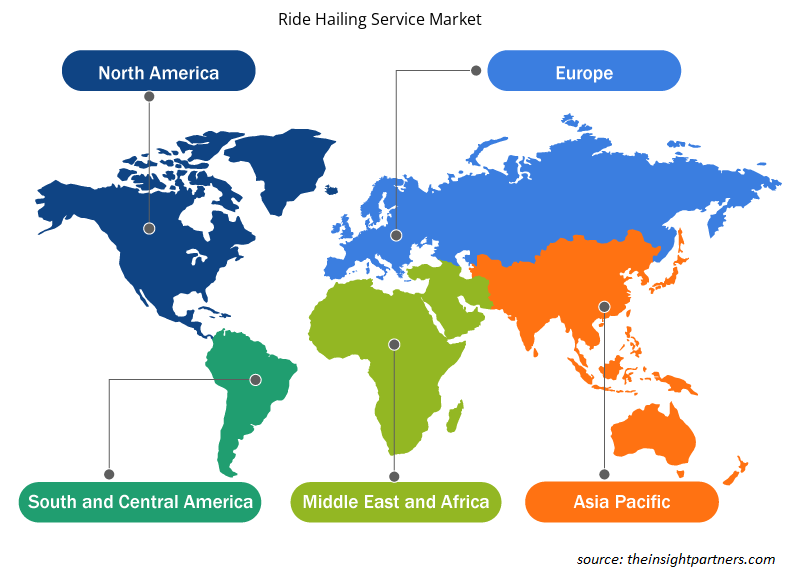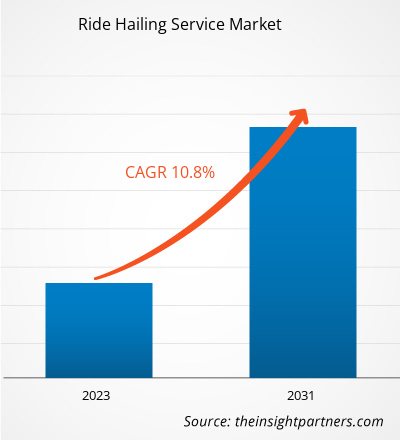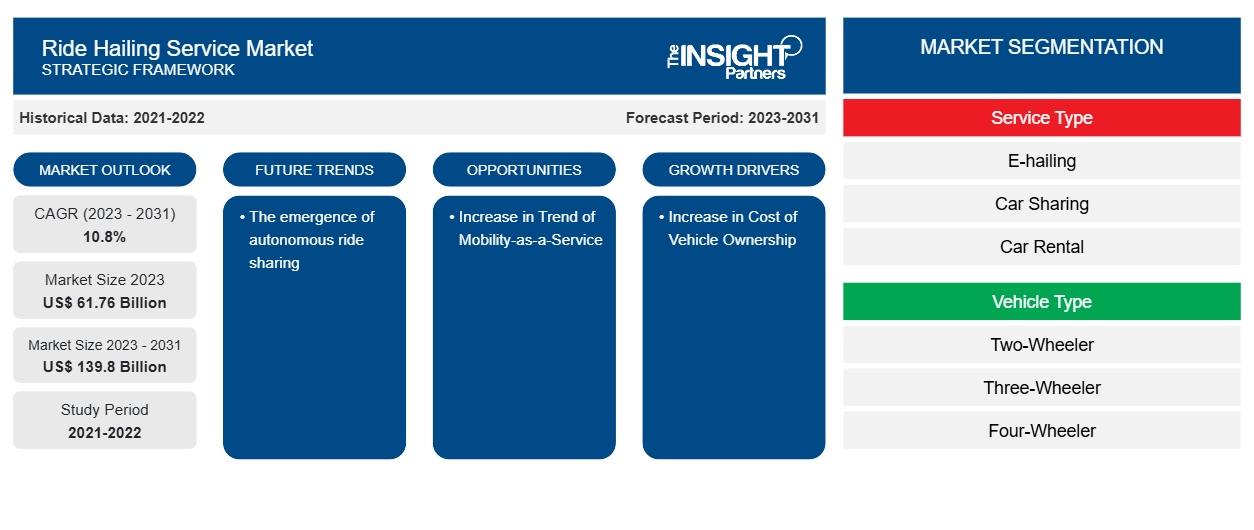Der Markt für Mitfahrdienste soll von 61,76 Milliarden US-Dollar im Jahr 2023 auf 139,8 Milliarden US-Dollar im Jahr 2031 anwachsen. Für den Zeitraum 2023–2031 wird ein durchschnittliches jährliches Wachstum von 10,8 % erwartet. Das Aufkommen autonomer Mitfahrdienste dürfte ein wichtiger Trend auf dem Markt bleiben.CAGR of 10.8% during 2023–2031. The emergence of autonomous ride-sharing is likely to remain a key trend in the market.
Marktanalyse für Mitfahrdienste
Der weltweite Anstieg des Trends zu On-Demand-Transportdiensten dürfte das Marktwachstum in den kommenden Jahren vorantreiben. Darüber hinaus dürften die steigenden Kosten für den Fahrzeugbesitz die Nachfrage nach Mitfahrdiensten im Prognosezeitraum ankurbeln. Darüber hinaus wird erwartet, dass ein weltweiter Anstieg des Trends zu Mobilität als Dienstleistung das Wachstum des Marktes für Mitfahrdienste von 2023 bis 2031 weiter vorantreiben wird.
Marktübersicht für Ridesharing-Dienste
Zu den wichtigsten Stakeholdern im Ökosystem des Ride-Hailing-Marktes gehören Anbieter von Technologielösungen, Anbieter von Ride-Hailing-Diensten und Endnutzer. Zu den Anbietern von Technologielösungen gehören Hersteller von vernetzten Geräten oder anderer Hardware sowie Softwareentwickler. Die steigende Zahl der Anbieter von Technologielösungen treibt die Digitalisierung im Ride-Hailing entscheidend voran. Es wird erwartet, dass Ride-Hailing-Dienste nach COVID zunehmen werden, da der Trend zu On-Demand-Transportdiensten steigt, neue Arbeitsplätze geschaffen werden und die Millennials nur wenige Autos besitzen. Darüber hinaus treiben technologische Fortschritte bei vernetzten und automatischen Fahrzeugen zur Reduzierung der CO2-Emissionen und erhebliche Verkaufssteigerungen dieser intelligenten und effizienten Fahrzeuge für die Nutzung von Ride-Hailing-Diensten das globale Marktwachstum voran. Die Ride-Hailing-Dienstleister nehmen Dienstleistungen von Anbietern von Technologielösungen in Anspruch. Mit den wachsenden technologischen Entwicklungen im Ride-Hailing steigt die Nachfrage nach einem Ride-Hailing-Dienstmarkt.
Passen Sie diesen Bericht Ihren Anforderungen an
Sie erhalten kostenlos individuelle Anpassungen an jedem Bericht, einschließlich Teilen dieses Berichts oder einer Analyse auf Länderebene, eines Excel-Datenpakets sowie tolle Angebote und Rabatte für Start-ups und Universitäten.
-
Holen Sie sich die wichtigsten Markttrends aus diesem Bericht.Dieses KOSTENLOSE Beispiel umfasst eine Datenanalyse von Markttrends bis hin zu Schätzungen und Prognosen.
Treiber und Chancen auf dem Ridesharing-Markt
Anstieg der Fahrzeugbesitzkosten begünstigt den Markt
Finanzierung, Kraftstoff, Instandhaltung, Zulassung/Steuern und Wartung sowie Wertverlust tragen alle zu den Kosten des Autobesitzes bei. Die Kosten für den Besitz eines Fahrzeugs steigen von Jahr zu Jahr. Der Wertverlust macht laut der American Automobile Association (AAA) mehr als 43 % der Gesamtbetriebskosten aus. Die anderen Kosten wie Wartung und Benzin machen jedoch 25 % aus. Der Anstieg der Kraftstoffpreise und Wartungskosten hat in den letzten 10 Jahren dramatisch zugenommen und wird in den kommenden Jahren voraussichtlich weiter zunehmen. Obwohl der Autobesitz während der Pandemie zugenommen hat, wird erwartet, dass er nach 2021 zurückgeht und auf das Niveau vor der Pandemie zurückkehrt. Dadurch können Ride-Hailing-Anbieter von dieser demografischen Entwicklung profitieren, da die neue technologieaffine Generation zu den aktivsten Nutzern dieser Dienste gehört.pre-pandemic levels. This allows ride-hailing providers to benefit from this demographic development, as the new technology-savvy generation is among the most active users of these services.
Zunehmender Trend zu Mobility-as-a-Service
Kunden, die sich kein Fahrzeug leisten können, können dank der Mobilitätsdienste problemlos reisen. Mobility-as-a-Service senkt die Kosten für Besitz und Betrieb, indem die Kosten für Carsharing und Mitfahrdienste maximiert werden. Darüber hinaus führt die rasante Urbanisierung bereits zu Verkehrsstaus. Das Konzept Mobility-as-a-Service (MaaS) könnte eine bessere Wahl sein, um Verkehrsstaus durch eine stärkere Nutzung des bestehenden öffentlichen und privaten Verkehrsnetzes zu minimieren. Die dringende und gestiegene Nachfrage nach effektiven Lösungen zur Bewältigung des Verkehrs in Smart Cities wird voraussichtlich das Wachstum des Marktes für Mitfahrdienste bis 2031 ankurbeln. Daher wird erwartet, dass der zunehmende Trend zu Mobility-as-a-Service (MaaS) das Wachstum des globalen Marktes für Mitfahrdienste ankurbelt.MaaS) concept may be a better choice for minimizing traffic congestion by greater use of existing public and private transportation network. The urgent and increased demand for effective solutions to handle traffic in smart cities which in turn is expected to fuel ride hailing service market growth through 2031. Therefore, the increasing trend of mobility as a Service (MaaS) is expected to fuel the growth of the global ride-hailing service market.
Segmentierungsanalyse des Ride-Hailing-Service-Marktberichts
Wichtige Segmente, die zur Ableitung der Marktanalyse für Mitfahrdienste beigetragen haben, sind Servicetyp, Fahrzeugtyp, Standort und Endbenutzer
- Basierend auf dem Servicetyp ist der Markt für Mitfahrdienste in E-Hailing, Carsharing, Autovermietung und stationsbasierte Mobilität unterteilt. Das E-Hailing-Segment hatte im Jahr 2023 den größten Marktanteil.
- Nach Fahrzeugtyp ist der Markt in Zweiräder, Dreiräder, Vierräder und andere unterteilt. Das Segment der Vierräder hatte im Jahr 2023 den größten Marktanteil.
- Auf der Grundlage des Standorts ist der Markt in städtisch und ländlich unterteilt. Das städtische Segment hielt im Jahr 2023 einen erheblichen Marktanteil.
- Nach Endnutzern ist der Markt in institutionelle und private Nutzer unterteilt. Das institutionelle Segment hatte im Jahr 2023 den größten Marktanteil.
Marktanteilsanalyse für Ride-Hailing-Dienste nach geografischer Lage
Der geografische Umfang des Marktberichts zu Mitfahrdiensten ist hauptsächlich in fünf Regionen unterteilt: Nordamerika, Asien-Pazifik, Europa, Naher Osten und Afrika sowie Südamerika.
Der Umfang des Berichts zum Markt für Mitfahrdienste umfasst Nordamerika (USA, Kanada und Mexiko), Europa (Deutschland, Frankreich, Italien, Spanien, Großbritannien und das übrige Europa), den asiatisch-pazifischen Raum (China, Indien, Australien, Japan, Südkorea und den übrigen asiatisch-pazifischen Raum), den Nahen Osten und Afrika (Südafrika, Saudi-Arabien, Vereinigte Arabische Emirate und den übrigen Nahen Osten und Afrika) sowie Südamerika (Brasilien, Argentinien und den übrigen Südamerika). In Bezug auf den Umsatz dominierte der asiatisch-pazifische Raum im Jahr 2023 den Marktanteil der Mitfahrdienste. Nordamerika war der zweitgrößte Umsatzträger zum globalen Markt für Mitfahrdienste, gefolgt von Europa.UAE, and Rest of Middle East & Africa), and South America (Brazil, Argentina, and the Rest of South America). In terms of revenue, Asia Pacific dominated the ride hailing service market share in 2023. North America was the second-largest revenue contributor to the global ride hailing service market, followed by Europe.
Regionale Einblicke in den Ride-Hailing-Service-Markt
Die regionalen Trends und Faktoren, die den Ride-Hailing-Service-Markt während des Prognosezeitraums beeinflussen, wurden von den Analysten von Insight Partners ausführlich erläutert. In diesem Abschnitt werden auch die Marktsegmente und die Geografie des Ride-Hailing-Service-Marktes in Nordamerika, Europa, im asiatisch-pazifischen Raum, im Nahen Osten und Afrika sowie in Süd- und Mittelamerika erörtert.

- Erhalten Sie regionale Daten zum Ride-Hailing-Dienstmarkt
Umfang des Ride-Hailing-Service-Marktberichts
| Berichtsattribut | Details |
|---|---|
| Marktgröße im Jahr 2023 | 61,76 Milliarden US-Dollar |
| Marktgröße bis 2031 | 139,8 Milliarden US-Dollar |
| Globale CAGR (2023 - 2031) | 10,8 % |
| Historische Daten | 2021-2022 |
| Prognosezeitraum | 2023–2031 |
| Abgedeckte Segmente |
Nach Servicetyp
|
| Abgedeckte Regionen und Länder |
Nordamerika
|
| Marktführer und wichtige Unternehmensprofile |
|
Marktteilnehmerdichte: Der Einfluss auf die Geschäftsdynamik
Der Markt für Ride-Hailing-Dienste wächst rasant, angetrieben von der steigenden Nachfrage der Endnutzer aufgrund von Faktoren wie sich entwickelnden Verbraucherpräferenzen, technologischen Fortschritten und einem größeren Bewusstsein für die Vorteile des Produkts. Mit steigender Nachfrage erweitern Unternehmen ihr Angebot, entwickeln Innovationen, um die Bedürfnisse der Verbraucher zu erfüllen, und nutzen neue Trends, was das Marktwachstum weiter ankurbelt.
Die Marktteilnehmerdichte bezieht sich auf die Verteilung von Firmen oder Unternehmen, die in einem bestimmten Markt oder einer bestimmten Branche tätig sind. Sie gibt an, wie viele Wettbewerber (Marktteilnehmer) in einem bestimmten Marktraum im Verhältnis zu seiner Größe oder seinem gesamten Marktwert präsent sind.
Die wichtigsten auf dem Markt für Mitfahrdienste tätigen Unternehmen sind:
- ANI Technologies Private Limited
- Daimler AG
- Delphi Technologies PLC
- DiDi Global Inc.
- Gett
- Grab Holdings Inc.
Haftungsausschluss : Die oben aufgeführten Unternehmen sind nicht in einer bestimmten Reihenfolge aufgeführt.

- Überblick über die wichtigsten Akteure auf dem Ride-Hailing-Service-Markt
Neuigkeiten und aktuelle Entwicklungen zum Ride-Hailing-Dienstmarkt
Der Markt für Mitfahrdienste wird durch die Erhebung qualitativer und quantitativer Daten nach Primär- und Sekundärforschung bewertet, die wichtige Unternehmensveröffentlichungen, Verbandsdaten und Datenbanken umfasst. Nachfolgend sind einige der Entwicklungen auf dem Markt für Mitfahrdienste aufgeführt:
- Der Ridesharing-Dienstleister Kakao Mobility hat seine Präsenz durch die Einführung von Ridesharing-Diensten in Asien und dem Nahen Osten erweitert. (Quelle: Kakao Mobility, Pressemitteilung, November 2023)
- DiDi Global Inc. hat mit der Registrierung von Fahrern in Kapstadt, Südafrika, begonnen und bietet Fahrdienste für Verbraucher in der zweitgrößten Stadt des Landes an. (Quelle: DiDi Global Inc., Pressemitteilung, März 2021)
Marktbericht zu Mitfahrdiensten – Umfang und Ergebnisse
Der Bericht „Marktgröße und Prognose für Ride-Hailing-Dienste (2021–2031)“ bietet eine detaillierte Analyse des Marktes, die die folgenden Bereiche abdeckt:
- Marktgröße und Prognose für Ride-Hailing-Dienste auf globaler, regionaler und Länderebene für alle wichtigen Marktsegmente, die im Rahmen des Berichts abgedeckt sind
- Markttrends für Mitfahrdienste sowie Marktdynamik wie Fahrer, Einschränkungen und wichtige Chancen
- Detaillierte PEST- und SWOT-Analyse
- Marktanalyse für Mitfahrdienste mit Blick auf wichtige Markttrends, globale und regionale Rahmenbedingungen, wichtige Akteure, Vorschriften und aktuelle Marktentwicklungen
- Branchenlandschaft und Wettbewerbsanalyse, die die Marktkonzentration, Heatmap-Analyse, prominente Akteure und aktuelle Entwicklungen für den Markt für Mitfahrdienste umfasst
- Detaillierte Firmenprofile
- Historische Analyse (2 Jahre), Basisjahr, Prognose (7 Jahre) mit CAGR
- PEST- und SWOT-Analyse
- Marktgröße Wert/Volumen – Global, Regional, Land
- Branchen- und Wettbewerbslandschaft
- Excel-Datensatz
Aktuelle Berichte
Erfahrungsberichte
Grund zum Kauf
- Fundierte Entscheidungsfindung
- Marktdynamik verstehen
- Wettbewerbsanalyse
- Kundeneinblicke
- Marktprognosen
- Risikominimierung
- Strategische Planung
- Investitionsbegründung
- Identifizierung neuer Märkte
- Verbesserung von Marketingstrategien
- Steigerung der Betriebseffizienz
- Anpassung an regulatorische Trends























 Kostenlose Probe anfordern für - Markt für Mitfahrdienste
Kostenlose Probe anfordern für - Markt für Mitfahrdienste